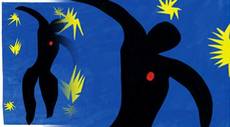Ferrara show delves into secrets of Matisse atelier
Fully 113 works by French master exhibited in Ferrara palazzo
21 febbraio, 18:13 (by Nicoletta Castagni)
(ANSA) - Ferrara, February 21 - Henri Matisse, a French
artist of international renown, and his creative processes are
the focus of a new exhibition that runs though June 15 at
Palazzo dei Diamanti.
(by Nicoletta Castagni)
(ANSA) - Ferrara, February 21 - Henri Matisse, a French
artist of international renown, and his creative processes are
the focus of a new exhibition that runs though June 15 at
Palazzo dei Diamanti.A total of 113 of the highly acclaimed artist's works - including bronzes, drawings, and paintings - on loan from private and public collections around the world have been arranged so as to echo the atelier of this modern-day genius and highlight his obsession with the female figure. At a cost of some two million euros, "the exhibition aims to provide visitors with insight into the mystery of this artist who influenced twentieth-century art to such a large extent," said the director of Musei Civici di Ferrara and head of the programming for Palazzo dei Diamanti, Maria Luisa Pacelli.
Preparations for the exhibition 'Matisse. The Figure' began eight years ago, and Pacelli has brought to the northern Italian city invaluable works from the collections of New York's Metropolitan Museum of Art as well as the city's Museum of Modern Art; France's Orangerie and Pompidou museums; the Nice Matisse Museum; London's Tate Gallery; and many private art collectors. The result is a cohesive, carefully structured exhibition of Matisse's artistic production, despite the refusal by some major collections to lend several works.
That includes both public institutions like St.
Petersburg's Hermitage in Russia, which is in the process of organizing celebrations for the museum, and private ones such as the Pinacoteca Agnelli, which wanted a work of equal value on loan. The Ferrara exhibition underscores the "extensive syncretism between the various techniques" that Matisse used, putting at the same level the bronze sculptures, drawings and paintings of incredibly vivid hues. The exhibit halls have been arranged in chronological order while focusing on specific themes.
From the section on the artist's early years at the school of the symbolist Moreau, one can see the close links between his works in charcoal and oil and his sculptures. The dense "dialogue" between them manages to transfer the impact of colors used to great effect by the Fauves to the plastic arts, "achieving a surface so lively as to evoke vibrant, bright colors". The exhibition then focuses on an impressive series of nudes, in which Matisse's exploration of African and tribal art is apparent and from which his genius shapes "the concept of a new sort of beauty".
This section begins with the small bronze sculpture 'Reclining Nude I (Aurora)', which was inspired by a Michelangelo at the Medici Chapel, and then moves on to the same sculptural volumes on canvas, with 'Nude with a White Scarf, 'A Sitting Nude', and 'Still Life with Ivy'. Also included is the extraordinary 'Serpentine', a sculpture Matisse worked on for years while at the same time seeking the rhythm, twists and incredible three-dimensional movement found in 'Dance'. His worked incessantly, creating portraits such as the two 'Jeanette' heads and later in the oil paintings of his daughter Marguerite and the gypsy girl Joaquina. His 'Back' series of nudes moves more towards abstract art, in which Matisse interpreted the entire French painting tradition of the nineteenth century in his own unique fashion.
The end of WWI shifted the artist's focus back to lightness, decoration and triumphantly vivid colors. This was the Odalisque phase of the 1920s, when he was living in Cote Azure and reconstructed veritable set designs using various objects, clothing, and fabric bought years before in Morocco, to then move on to furs and haute couture attire ('The White Fox', 'Girl with a Fur Coat, Yellow Background'). Also included is the beautiful 'Still Life with Sleeping Woman' from Washington's National Gallery of Art, which in the 1940s marked the grand master's return to repeated, obsessive lines. The exhibition ends with a section with the 'Jazz' prints, the canvases from the Venice atelier, and works like 'Young Girl in White on a Red Background', which bears witness to his collages phase, despite the fact that it is painting.










